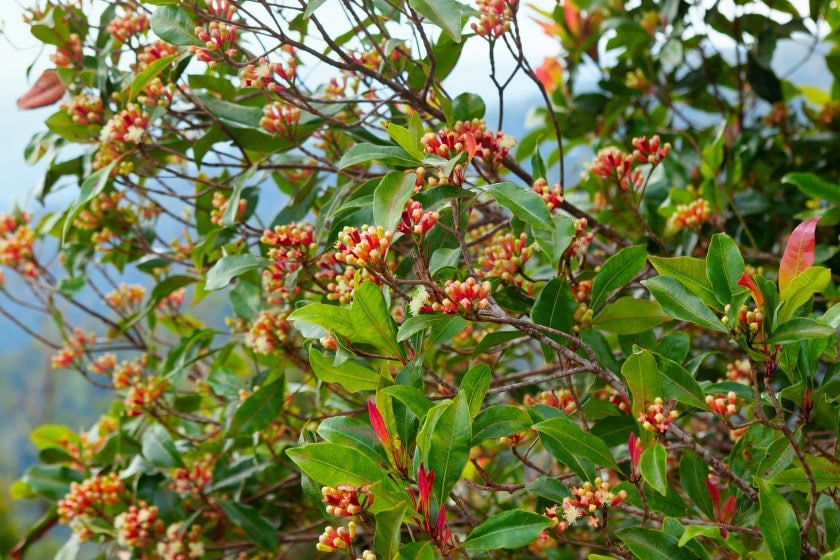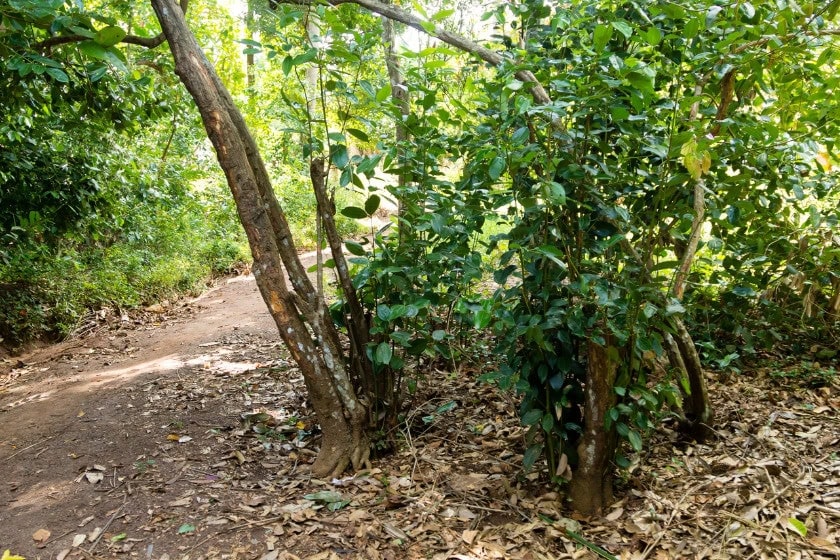Zanzibar – the very name has a romantic, exotic ring to it! It evokes images of palm-fringed beaches, warm blue seas, and exotic resorts. To this day, spice production is one of Zanzibar’s two main industries, the other being tourism. The Zanzibar archipelago, part of Tanzania and just 35 km/22 mi off its coast, is still often referred to as the ‘Spice Islands’.
Cloves, cinnamon, nutmeg, and black pepper are still being produced in significant amounts. Besides Zanzibar’s beautiful hotels and resorts, the island is also known for its rich cultural heritage and lush and diverse flora. The islands are home to a variety of interesting plants, some of which play significant roles in Zanzibar’s local customs, cuisine, and economy. Here are five of the most distinctive plants you’ll find on this island paradise:
1. Clove Trees

Clove trees are remarkable evergreens that originate from the Maluku Islands in Indonesia. They thrive in tropical Zanzibar and are a significant feature of Zanzibar’s lush green landscapes. The red flower buds, from which the spice is obtained, are noted for their intense fragrance and strong flavour.
The flower buds are meticulously handpicked from September to December. They’re dried in the sun for several days, which turns them their familiar deep brown colour. This drying process is a crucial step that concentrates the aromatic compounds in the cloves, ensuring their distinctive taste and long shelf life.
Habitat:
These trees flourish in the archipelago’s hot, humid tropical climate, with its fertile, well-drained soils and the perfect ratio of rain to sunshine. These perfect conditions, particularly in the island’s central and northern parts, allow the trees to grow to heights of up to eight to 12 meters. Visitors to Zanzibar can take guided spice tours to learn about clove and other spice production.
Interesting Fact:
During the 19th century, Zanzibar dominated the world’s clove markets. Though this is no longer the case, clove production remains an important part of the islands’ economy. Cloves are also integral to local traditions, cuisine, and even medicine.
2. Zanzibar Red Banana

Zanzibar’s red bananas are attractive plants with large, lush green leaves. Their fruits are generally smaller and plumper than those of the more common yellow Cavendish bananas. When ripe, the skins of red bananas are a deep red or maroon colour. The flesh is quite soft and sweet and can be light pink or cream in colour. They have a higher beta-carotene and vitamin C content and also have a longer shelf life. They have several other names, of which ‘claret banana’ is one of the more descriptive. Their complex flavour often has hints of raspberry.
Habitat:
Red bananas are a testament to Zanzibar’s botanical diversity and are generally grown on small-scale farms and in domestic gardens. The island’s tropical climate and fertile soils are ideal for the plants, ensuring they develop their full flavour and striking colouration.
Interesting Fact:
Zanzibar’s red bananas are ingrained in the local cuisine. It’s a common ingredient of local desserts, where it’s often sliced and caramelised to enhance its sweet taste. It’s also mashed into a puree and used in cakes, pastries, smoothies, and cocktails.
3. Pepper Vines

Black pepper is one of the prominent spices cultivated on the islands. It’s a key component of Zanzibar’s agricultural landscape and is sometimes referred to as the ‘king of spices’. Black pepper is derived from a woody climbing vine with broad, shiny leaves, and it may reach heights of up to 10 m/33 ft.
It anchors itself by aerial roots to a pole or tree. Black pepper grows in bunches (like grapes) called drupes. Zanzibar’s black peppercorns are harvested by hand, immersed in boiling water, and then dried in the sun. They have a distinctive fruity and spicy odour and a hot, pungent taste, mainly due to aromatic oils and the chemical piperine. Some specific Zanzibar black pepper varieties include ‘Ajabu’ and ‘Uthamini’.
Habitat:
Pepper vines need a lot of rain and warmth, so Zanzibar’s tropical climate suits them. They also need partial shade to grow their best, so they are often grown in the clove plantations on the islands. Zanzibar’s black pepper is generally grown on organic farms in cooperation with small-scale farmers.
Interesting Fact:
Red, white, and black pepper come from the same plant! The colour depends on the time of harvesting and how the peppercorns are processed.
4. Cinnamon Trees

Cinnamon trees are a vital and fragrant part of Zanzibar’s spice legacy. These slender, evergreen trees can grow to 10–15 m tall. But it’s the tree’s inner bark that holds the magic! This is the part that contains the essential oils, most notably cinnamaldehyde, which gives the spice its distinctive warm, sweet flavour. This inner bark is harvested without killing the tree by making cuts in the tree’s trunk and branches.
The inner bark is skilfully peeled away, and it then curls into ‘quills’ as it dries. These quills are cut into familiar sticks or ground into powder, as the cinnamon spice is found in kitchens everywhere. Harvesting cinnamon is a skilful craft often passed down through generations of farmers. A tree must be at least two years old before it can be harvested for the first time. It’s then allowed to mature further and will continue to produce valuable bark for many years.
Habitat:
Zanzibar, with its warm, tropical climate and rich, fertile soils, provides an ideal environment for the cultivation of cinnamon trees. The trees are found in large-scale plantations, on a smaller scale, and in home gardens.
Interesting Fact:
Cinnamon is not only used as a flavouring agent, but its antiseptic properties allow it to be used to treat various ailments, ranging from colds to digestive issues. Its essential oil is extracted and used in aromatherapy, cosmetics, and personal care products.
5. Raffia Palm

This fast-growing palm can reach 10 m/33 ft in height and has a large spreading crown. It bears pendulous inflorescences with dense flowers that develop into heavy bunches of fruit that can be eaten once boiled. The kernels can be processed to produce edible oil. Sap obtained from the trunk is made into palm wine and other sweet drinks. Its main commercial use is the production of strong multipurpose fibres called raffia and piassava, which are obtained from the leaves.
Skilled artisans weave the raffia fibres into a variety of items, such as mats, baskets, and hats. The weaving process is intricate and often involves the whole community, with different roles in preparing, dyeing, and weaving the raffia fibres. Other products made include ropes and brooms. A waxy substance on the lower surface of the leaves is used as a polish, and the oil extract from the fruit kernels is used in soap making.
Habitat:
Zanzibar’s swamps and natural wetlands offer perfect conditions for the raffia palm. They flourish and form clusters that support a plethora of wildlife and other plant species, adding to the islands’ biodiversity.
Interesting Fact:
Raffia palms are known for having the largest leaves of all palm trees, making them ideal for thatching and many other handicrafts that contribute to Zanzibar’s economy.
At Discover Africa, we know that Zanzibar’s rich biodiversity extends beyond its beautiful beach habitats, gorgeous bird species, rich marine life, and interesting land animals. Its diverse plant life has contributed greatly to making Zanzibar a popular vacation spot throughout the world. Whether you’re a serious botanist or just love green and verdant spaces filled with thriving plants, a holiday tour to Zanzibar will not disappoint. Contact us to help you plan a tailor-made luxury holiday to Zanzibar‘s magical shores!
Author: Matthys Van Aswegen
Published:
Last Update:
Part of the Zanzibar Safari Collection